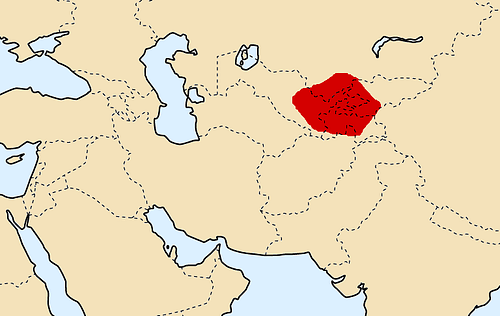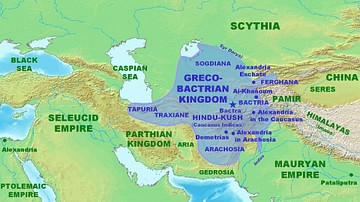
Sogdiana (or Sogdia) is a region in Central Asia between the mighty rivers Iaxartes in the north and Oxus in the south. Its eastern and western limits are more difficult to determine, especially since the toponym Sogdiana covered different areas at different times.
At times it kept the Oxus as its southern border until the Pamir Mountains; in other times, the Sogdian Mountains and the beginning of the northern Ferghana Valley were the eastern frontline of the area. In the West, the Aydar Lake and the southeastern border of the Kyzyl Kum desert were Sogdiana's border. Except for the two major rivers that limit Sogdiana to the north and south, the area is also divided at his center by the "very revered Polytimetos" river, (Curtius VII.10.1-3 : Polytimetum vocant incolae), today Zerafshan, and by others whose ancient names are lost to us.
Sogdiana constituted the northern frontier of the sedentary world and thus was in constant contact with steppe nomads. Sogdian society was an agricultural one, based on the irrigation of very fertile loess soil. The area is known to have produced semi-precious stones, like lapis lazuli and carnelian or garnet.
Pre-Achaemenid Sogdiana has known urban settlement phases before the arrival of Iranian speakers of the Iron Age known as "Sogdians". The area passed under Achaemenid control under Cyrus, between 546 and 539 BC (Herodotos I.153,177), but even if they probably first controlled it entirely, the northern point being the town known by the Greeks as Kuropolis, it seems that over time the Persian rule recentred south around Marakanda. The area was not turned into a satrapy, but was administered by the the Bactrian satrap. Sometimes Sogdiana, due to its Bactrian ownership, was given by the Great Kings to their sons that weren't destined to be heir or to their relatives. Examples are Masistos son of Darius I (Herodotos IX.113.1-11), maybe Hystaspes son of Xerxes I (Diodoros XI.69.3 ; Ktesias FGrHist 688F13), and then Bessos, relative of Darius III (Arrian III.21.5).
This last ruler made the subsequent Macedonian conquest difficult: Having killed Darios III, Bessos named himself king and ruled over Bactria. After he fled to Sogdiana in 329 BC upon hearing Alexander's invasion on the Paropamisadai, he was betrayed and given to Alexander by the Sogdian Spitamenes. Spitamenes later waited for Alexander to pass through Sogdiana to Ferghana to rebel again, but had not better luck than Bessos. Both rebellions were motivated by the Bactrian and Sogdian nobles who were determined to maintain at all costs the privileged socio-political status that they had enjoyed under the Achaemenid regime. They were well-provided with military, money, manpower, and alliances with nomads in the north. Apama, the daughter of Spitamenes, became the wife of Seleucos in the spring of 324 BC. In 293 BC, Antiochos was appointed vice-king of the Upper-Satrapies by his father. He led an expedition against northern nomads around this date, but about 280 BC, those nomads made strong incursions into the Seleucid Empire, passing through Sogdiana. Antiochos expelled them, then tried to reinforce the northern border, bringin among other things a new wave of Greek colonists.
Nevertheless, the Greek dominion on the area was probably not strong, only concentrated in towns. The strong link of Sogdiana and Bactria emerged once again when the Greeks of Bactria became independent under Diodotos. Sogdiana was incorporated into the Greco-Bactrian Kingdom until Euthydemos' late reign, in the 210's BC, when the Sogdians once more became independent. Eucratides of Bactria succeeded to take it back up to the area around Marakanda in the 170's BC, but soon after first the Sakas and then the Yuezhei overthrew Greek dominion. Even if the Yuezhei probably made their royal court in the Polytimetos Valley, the center of political events moved south once again, and Sogdiana kept its role of frontline area in the Kushan empire until the Middle Ages.





